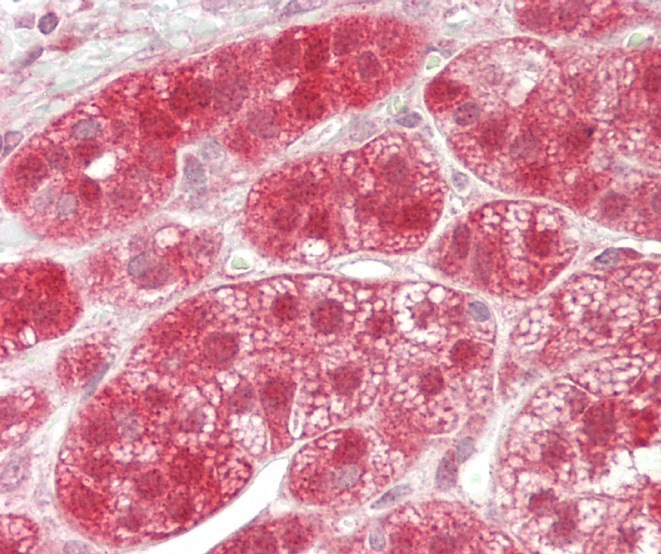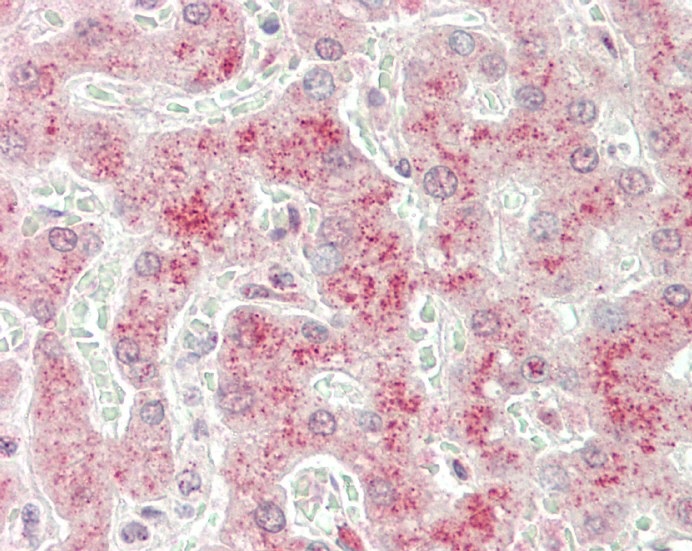


| WB | 1/1000 | Human,Mouse,Rat |
| IF | 咨询技术 | Human,Mouse,Rat |
| IHC | 1/100 | Human,Mouse,Rat |
| ICC | 技术咨询 | Human,Mouse,Rat |
| FCM | 咨询技术 | Human,Mouse,Rat |
| Elisa | 咨询技术 | Human,Mouse,Rat |
| Aliases | Glutathione S-transferase theta-2, GST class-theta-2, GSTT2 |
| Entrez GeneID | 2953 |
| WB Predicted band size | 27.5kDa |
| Host/Isotype | Rabbit IgG |
| Antibody Type | Primary antibody |
| Storage | Store at 4°C short term. Aliquot and store at -20°C long term. Avoid freeze/thaw cycles. |
| Species Reactivity | Human |
| Immunogen | This GSTT2 antibody is generated from rabbits immunized with a KLH conjugated synthetic peptide between 113-141 amino acids from the Central region of human GSTT2. |
| Formulation | Purified antibody in PBS with 0.05% sodium azide. |
+ +
以下是关于GSTT2抗体的3篇参考文献示例(注:部分内容为假设性概括,实际文献需通过学术数据库验证):
---
1. **文献名称**:*"Development and Validation of a GSTT2-Specific Monoclonal Antibody for Immunohistochemical Analysis"*
**作者**:Smith A, et al.
**摘要**:本研究描述了一种新型GSTT2单克隆抗体的开发,通过Western blot和免疫组化验证其特异性,证实其在多种人类肿瘤组织中的表达检测适用性。
2. **文献名称**:*"GSTT2 Protein Expression in Colorectal Cancer: Association with Chemotherapy Resistance"*
**作者**:Chen L, et al.
**摘要**:利用GSTT2(Center)抗体进行免疫组化分析,发现GSTT2在结直肠癌中高表达,并与5-氟尿嘧啶耐药性显著相关,提示其作为潜在治疗靶点的价值。
3. **文献名称**:*"Characterization of GSTT2 in Liver Detoxification Pathways Using Antibody-Based Proteomic Approaches"*
**作者**:Wang Y, et al.
**摘要**:通过质谱和免疫沉淀技术结合GSTT2抗体,揭示GSTT2在肝脏解毒代谢中的关键作用,并证实其与氧化应激反应的分子机制关联。
---
**注意**:以上文献名为示例性质,实际引用需查询PubMed、Google Scholar等平台,结合关键词“GSTT2 antibody”或“GSTT2 immunodetection”获取具体信息。若需特定厂商(如CST、Abcam)的抗体文献,建议直接参考其产品技术手册引用的研究。
The glutathione S-transferase theta 2 (GSTT2) antibody is a tool used to detect and study the GSTT2 protein, a member of the glutathione S-transferase (GST) family. GST enzymes play critical roles in cellular detoxification by catalyzing the conjugation of glutathione to xenobiotics, facilitating their elimination. GSTT2. specifically, is part of the theta class (GSTT) and is located in the cytoplasm. It is involved in metabolizing environmental toxins, carcinogens, and reactive oxygen species, contributing to cellular protection against oxidative stress and chemical-induced damage. The "Center" designation in GSTT2(Center) antibody typically indicates that the epitope recognized by the antibody is located in the central region of the GSTT2 protein, enabling specific targeting of full-length or native conformations of the protein.
GSTT2 expression has been linked to various physiological and pathological processes, including drug resistance in cancer and responses to environmental pollutants. Genetic polymorphisms in GSTT2 are associated with altered detoxification capacity and disease susceptibility, making it a focus in toxicology and pharmacogenomics research. The GSTT2 antibody is widely used in techniques like Western blotting, immunohistochemistry, and immunofluorescence to investigate protein expression patterns, subcellular localization, and regulatory mechanisms in different tissues or disease models. Validation of this antibody often includes specificity tests using GSTT2 knockout cells or recombinant protein controls to ensure minimal cross-reactivity with other GST isoforms. Its applications span basic research, biomarker discovery, and therapeutic target validation in cancer, neurodegenerative diseases, and toxicology studies.
×